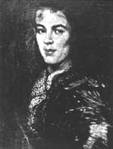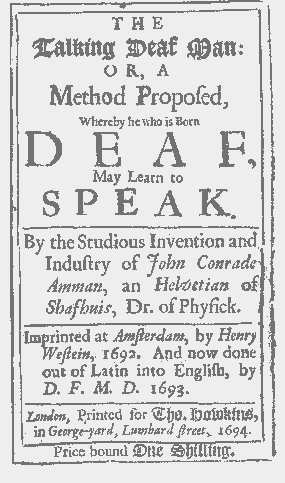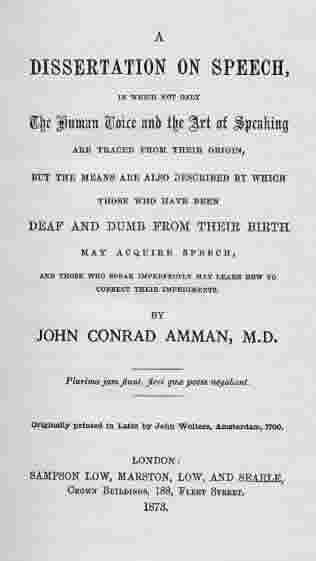John Conrad Amman
1669-1724
 John Conrad Amman was a Swiss physician practicing in the Netherlands. He wrote about instruction for the deaf and for those who stuttered. In his book Surdus loquens (Amsterdam, 1693) (The talking deaf man) he first wrote about voice and the difference between it and breathing. He then described the nature of speech sound production. He ended the book by laying out his educational program for teaching the deaf to talk.
John Conrad Amman was a Swiss physician practicing in the Netherlands. He wrote about instruction for the deaf and for those who stuttered. In his book Surdus loquens (Amsterdam, 1693) (The talking deaf man) he first wrote about voice and the difference between it and breathing. He then described the nature of speech sound production. He ended the book by laying out his educational program for teaching the deaf to talk.
Amman described his interest in teaching speech to his deaf students as follows:
After close investigation, I found that most of the mutes have their organs of speech perfect, and that they are speechless because they are deaf; and, although I have despaired of finding a remedy for removing their deafness, I have a different opinion respecting speech. For human speech, as will appear to every one who considers it with a little attention, is certain combination of many different kinds of sound, the variety of which arises, in my opinion, from the various motions of certain organs, which, if they were sufficiently visible, I should think would suffice for the deaf to discern them with the eyes, just as others receive sounds through their ears, and thus, in time they may learn to speak (Amman, 1692 cited in DeLand, 1920, 418).
His 1700 book Dissertatio de loquela (Dissertation in speech) was an expansion of his earlier book The speaking deaf. It, too, was a depiction of mechanisms and phonetics of speech production as well as an outline of methods he used to teach speech to his deaf students.
Amman’s primary speech therapy involved imitation. He had his students attend to his lips and larynx while he spoke, and then imitate these movements.
Amman is credited with the following discoveries in phonetics by John Ohala:
He made some original observations about speech articulations including a characterization of how laterals are produced (namely, that the lateral channel may lie in the buccal sulcus, not necessarily in the space enclosed by the teeth). He noticed nasals assimilating to the place of following stops in connected speech and he proposed a “natural” hierarchical classification of the features of speech, e.g., in assimilation and in pathological speech, substitution of one sound for another involves features at the lowest strata of the hierarchy, e.g., place, and not at the highest such as manner; thus substitutions of consonant for vowel, or nasal for fricative do not occur (Ohala, 2004).
Amman has described his treatment of two cases of stuttering. He succeeded in enabling one to read or speak before familiar people, but not to strangers (Hunt, 1869, p. 174).
Writings of John Conrad Amman

Amman, J. Conrad (1692) Surdus loquens. (The talking deaf man) or a method proposed whereby he who is born deaf may learn to speak. Amsterdam: Wetstenium. Reprinted Menston, Yorkshire: Scolar Press, 1972. In this book Amman strongly advocates spoken language as the most important means of communication for the deaf. http://www.gutenberg.org/files/13014/13014-8.txt Retrieved May 20, 2010.

Amman, J. Conrad (1700/1965). Dissertatio de loquela (Dissertation on speech). Introduction by R. W. Rieber. Translated by Charles Baker, Amsterdam: North Holland Publishing Co. Reprinted in 1965.
Writings about John Conrad Amman
DeLand, F. (1920). Ponce de Leon and Bonet. The Volta Review, 22, 7, 391-421.
Ohala, John (2004). Phonetics and phonology then, and then, and now. In H. Quene & V. van Heuven (eds.). On speech and language: Studies for Sieb G. Nooteboom. LOT Occasional Series 2. 133-140. Retrieved on May 20, 2010.
Hunt, J. (1861). Stammering and stuttering: Their nature and treatment. London, UK: Longman.
Rieber, R. (1965). Introduction to J.C. Amman, A dissertation on speech (C. Baker, Trans.). Amsterdam, Holland: North Holland Publishing Co.
